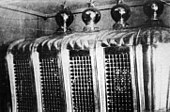ʿAlī ibn Husain Zain al-ʿĀbidīn
ʿAlī ibn Husain Zain al-ʿĀbidīn , or Ali Zain al-Abidin for short ( Arabic علي بن حسين زين العابدين, DMG ʿAlī bin Ḥusain Zain al-ʿĀbidīn ; * 658 in Medina ; † 713 in Medina), was the son of al-Husain and thus great-grandson of the Islamic prophet Mohammed . His mother was Shahr Banu , the daughter of the last Sassanid ruler Yazdegerd III. should have been. He should not only have been a descendant of Mohammed, but also an (unofficial) prince of Persia at the same time . That is why he became Ibn al-Chiyaratain /ابن الخيرتين / Called 'by the two best'. What is meant by this is his "doubly noble" descent - in both cases through the female line.
He was also called Imam Saddschad , which means something like prostrate because he was absorbed in his prayers for hours. He was the 4th Imam of the Shiites . In the battle of Karbala , in which his father was killed, he did not take part because of illness. He then led a quiet life in Medina . He refused to support the al-Muchtar uprising and stayed out of other political and religious disputes, in particular the revolt of Ibn Zubair after the death of Yazid I. After his death, two of his sons, Muhammad and , flared up Zaid , a dispute over his succession as Imam. He is buried in the al-Baqi 'cemetery in Medina, Saudi Arabia. His tomb was destroyed in 1926 after the Saudi conquest of the Hejaz kingdom by the Ichwān , fanatical supporters of the Wahhabis .
literature
- Phyllis G. Jestice (Ed.): Holy People of the World. A Cross-Cultural Encyclopedia. Volume 1. ABC-CLIO, Santa Barbara CA et al. 2004, ISBN 1-57607-355-6 , pp. 36-37 ( online copy ).
Web links
| personal data | |
|---|---|
| SURNAME | ʿAlī ibn Husain Zain al-ʿĀbidīn |
| BRIEF DESCRIPTION | Great-grandson of the prophet Mohammed |
| DATE OF BIRTH | 658 |
| PLACE OF BIRTH | Medina |
| DATE OF DEATH | 713 |
| Place of death | Medina |

